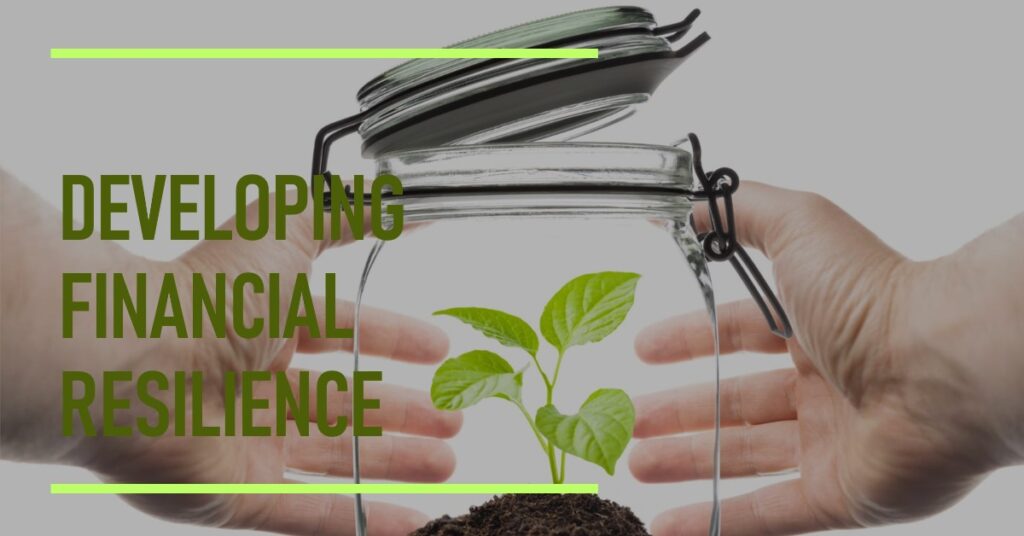In today’s fast-paced world, financial resilience is more crucial than ever. Whether it’s navigating economic downturns, unexpected expenses, or simply planning for the future, building financial resilience equips you with the tools and confidence to weather life’s financial storms. This guide will walk you through practical, actionable steps to strengthen your financial resilience, ensuring that you are better prepared for whatever comes your way.
1. Understanding Financial Resilience
Before diving into strategies, it’s important to understand what financial resilience really means. Financial resilience is the ability to withstand and recover from financial shocks. This could be anything from a sudden job loss, medical emergency, or a major unexpected expense. It’s not just about having money saved up; it’s also about having the right mindset, resources, and strategies to manage these challenges without compromising your financial stability.
2. Assessing Your Current Financial Situation
The first step in building financial resilience is to get a clear picture of where you currently stand financially. This involves taking stock of your income, expenses, assets, liabilities, and savings. Here’s how to do it:
- Track Your Income: Calculate your total monthly income, including salary, side gigs, and any passive income streams.
- List Your Expenses: Write down all your monthly expenses, from rent or mortgage payments to groceries, utilities, and discretionary spending.
- Evaluate Your Debts: List all your debts, including credit cards, student loans, and mortgages. Note the interest rates and monthly payments.
- Check Your Savings: Take note of your current savings, including emergency funds, retirement accounts, and other savings vehicles.
By assessing your financial situation, you can identify areas where you may be vulnerable and need to strengthen your financial resilience.
3. Building an Emergency Fund
An emergency fund is a cornerstone of financial resilience. It acts as a financial buffer that allows you to handle unexpected expenses without going into debt. Here’s how to build one:
- Set a Savings Goal: Aim to save at least three to six months’ worth of living expenses. This amount should cover essentials like housing, food, and utilities.
- Automate Your Savings: Set up automatic transfers to your savings account to ensure you consistently build your emergency fund.
- Choose the Right Account: Keep your emergency fund in a high-yield savings account that is easily accessible but separate from your regular checking account to avoid the temptation to spend it.
4. Managing Debt Effectively
Debt can be a significant barrier to financial resilience, especially if it comes with high interest rates. Managing and reducing your debt should be a priority.
- Create a Debt Repayment Plan: Focus on paying off high-interest debt first, such as credit cards, while making minimum payments on lower-interest debt.
- Consider Debt Consolidation: If you have multiple high-interest debts, consolidating them into a single loan with a lower interest rate can simplify your payments and reduce interest costs.
- Avoid Accumulating New Debt: Be mindful of your spending and avoid taking on new debt unless absolutely necessary.
5. Diversifying Income Streams
Relying solely on one source of income can leave you vulnerable if that income stream is disrupted. Diversifying your income is a powerful way to build financial resilience.
- Explore Side Gigs: Identify side hustles or freelance opportunities that align with your skills and interests. These can provide additional income and financial security.
- Invest in Passive Income: Consider investments that generate passive income, such as rental properties, dividend-paying stocks, or peer-to-peer lending.
- Enhance Your Skills: Continuously update and expand your skills to increase your value in the job market, which can lead to higher income opportunities.
6. Investing for the Future
While saving money is essential, investing is crucial for growing your wealth over time and achieving long-term financial resilience.
- Understand Your Risk Tolerance: Before investing, assess your risk tolerance to determine the types of investments that are right for you.
- Diversify Your Portfolio: Spread your investments across different asset classes, such as stocks, bonds, and real estate, to minimize risk.
- Regularly Review and Adjust: Monitor your investments and make adjustments as needed to stay aligned with your financial goals.
7. Protecting Your Assets
Insurance plays a critical role in financial resilience by protecting you from significant financial losses due to unexpected events.
- Health Insurance: Ensure you have adequate health insurance to cover medical expenses that could otherwise drain your savings.
- Property Insurance: Protect your home and valuables with homeowners or renters insurance.
- Life Insurance: If you have dependents, life insurance is essential to provide financial support for your loved ones in case of your untimely passing.
- Disability Insurance: Consider disability insurance to replace income if you are unable to work due to illness or injury.
8. Planning for Retirement
Retirement planning is a key aspect of long-term financial resilience. By preparing for your future, you ensure that you can maintain financial stability even after you stop working.
- Start Early: The earlier you start saving for retirement, the more time your money has to grow through compound interest.
- Maximize Employer Contributions: Take full advantage of employer-sponsored retirement plans, especially if your employer offers matching contributions.
- Regular Contributions: Make regular contributions to your retirement accounts, such as 401(k)s or IRAs, and increase the amount as your income grows.
9. Budgeting Wisely
A well-planned budget is the foundation of financial resilience. It helps you manage your money effectively and avoid overspending.
- Track Your Spending: Use budgeting tools or apps to monitor your spending and identify areas where you can cut back.
- Prioritize Needs Over Wants: Ensure that essential expenses, such as housing, food, and utilities, are covered before spending on discretionary items.
- Adjust as Needed: Review your budget regularly and make adjustments to reflect changes in your income, expenses, or financial goals.
10. Building a Strong Credit Score
A strong credit score is essential for financial resilience, as it affects your ability to borrow money at favorable rates and terms.
- Pay Bills on Time: Always pay your bills on time, as late payments can negatively impact your credit score.
- Keep Credit Utilization Low: Aim to use less than 30% of your available credit to maintain a healthy credit score.
- Regularly Check Your Credit Report: Review your credit report annually to ensure accuracy and address any errors promptly.
11. Staying Informed and Educated
Financial literacy is a critical component of financial resilience. The more you know about managing money, the better equipped you are to make informed decisions.
- Read Financial Books: Invest time in reading books on personal finance, investing, and wealth management.
- Attend Workshops and Seminars: Participate in financial education workshops, webinars, or courses to enhance your knowledge.
- Stay Updated on Economic Trends: Keep an eye on economic news and trends that could impact your financial situation, such as interest rate changes or market volatility.
12. Developing a Contingency Plan
Having a contingency plan is a proactive approach to managing financial risks. It ensures that you have a clear action plan in case of unexpected events.
- Identify Potential Risks: Consider various scenarios that could impact your finances, such as job loss, a market crash, or a health crisis.
- Create an Action Plan: Outline specific steps you would take in each scenario, such as cutting non-essential expenses, tapping into emergency savings, or seeking additional income sources.
- Review and Update: Regularly review and update your contingency plan to reflect changes in your financial situation or the broader economic environment.
13. Building a Support Network
Having a strong support network can significantly enhance your financial resilience. This network can provide guidance, advice, and emotional support during challenging times.
- Seek Professional Advice: Consider working with a financial advisor or planner to help you make informed decisions and develop a long-term financial strategy.
- Connect with Like-Minded Individuals: Join financial communities, online forums, or local groups where you can share experiences and learn from others.
- Lean on Friends and Family: Don’t hesitate to reach out to trusted friends or family members for support when needed.
14. Maintaining a Positive Mindset
Financial resilience isn’t just about money; it’s also about mindset. Maintaining a positive, proactive attitude toward your finances can help you stay focused and motivated.
- Stay Focused on Your Goals: Keep your financial goals in mind, and remind yourself of the progress you’ve made.
- Practice Gratitude: Acknowledge and appreciate the financial resources you have, which can help reduce stress and increase satisfaction.
- Be Adaptable: Life is unpredictable, and financial plans may need to change. Be willing to adapt and make adjustments as needed.
15. Regularly Reviewing Your Financial Resilience
Building financial resilience is an ongoing process. Regularly reviewing your progress and making adjustments as needed will help ensure that you remain financially resilient over time.
- Annual Financial Checkup: At least once a year, conduct a thorough review of your financial situation, including your savings, investments, debts, and insurance coverage.
- Adjust Goals as Necessary: As your life circumstances change, so too should your financial goals. Be flexible and adjust your plans to stay on track.
- Celebrate Milestones: Recognize and celebrate when you reach significant financial milestones, such as paying off a debt or reaching a savings goal. This will keep you motivated and committed to your financial journey.
Conclusion
Building financial resilience is a journey, not a destination. It requires a proactive approach, ongoing effort, and a willingness to adapt to changing circumstances. By following the steps outlined in this guide, you’ll be well on your way to achieving financial resilience and ensuring that you can navigate life’s financial challenges with confidence and peace of mind.



